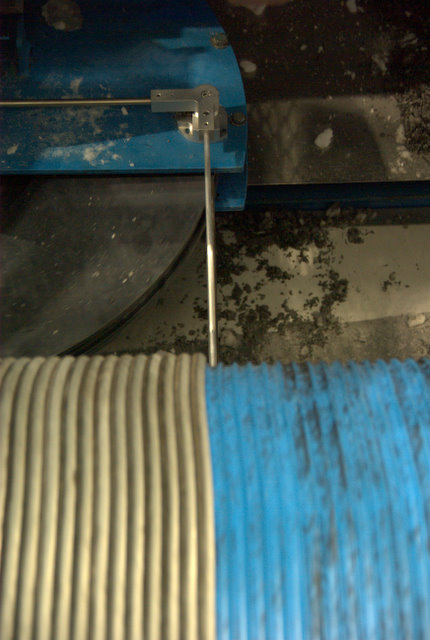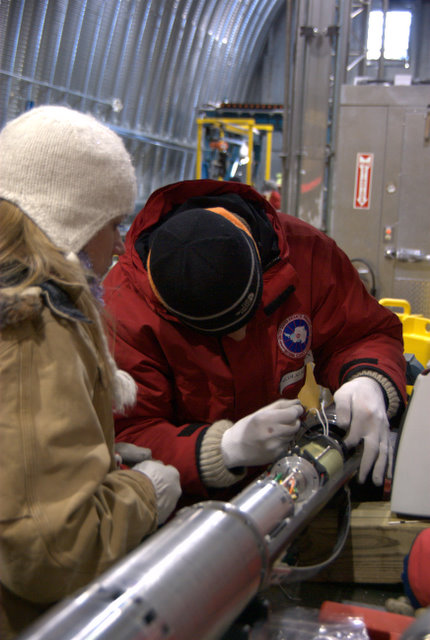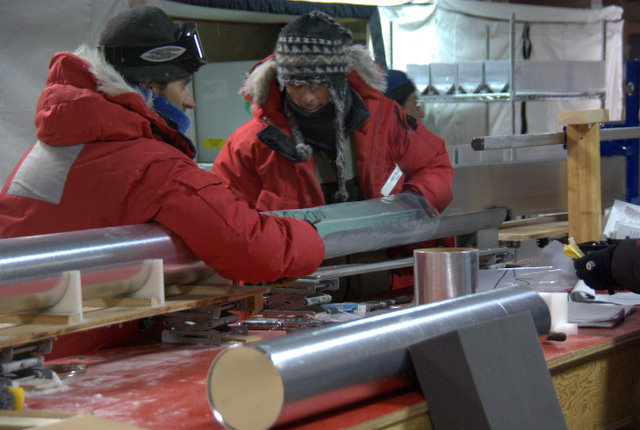Getting Ready to Drill at WAIS

Ice Cores from last year are being moved quickly to a Hercules C130
"cold
deck" flight. Last year we drilled though the zone known as
"brittle ice",
which needs to adjust to surface pressures for nearly a
year before
transporting. This year's cores are being flown out
this year since they are
part of the "brittle ice" zone and not as fragile.

Believe it or not, this room where the ice cores are handled is
refrigerated
to -20 C to keep the ice cores closer to the temperatures they see in
the
bore
hole. This room is insulated from the "warmer"
outside air, and fog hangs
in the air and frost coats everything as cores are moved to the plane.

A new 4 kilometer long cable needs to be installed on the winch this
year.
The old cable is too short, and was used for the first 2
seasons of drilling as
an "expendable cable" with the shorter depths of the early
seasons. This
cable is about 1/2" in diameter, and has two steel outer layers, 2
electrical
copper layers, and 7 inner optical fibers. Six of the
fibers are used to
communicate with the Sonde's (drill) two internal computers, the
seventh is
a spare. The copper layers run up to 1000 VDC at 10 Amps to power
the Sonde.
The steel layers handle up to 40,000 Newtons of force
to lift the Sonde and
with the ice core to the surface.

The very end of the cable as it is wrapped onto the winch drum.

This 150 horse power motor is the "Trip" motor that powers the winch
drum.
The trip motor is used raise and lower the Sonde in the bore hole in a
relatively
quick speed when precise control is not needed. Not pictured is
the 3 horse
power "drilling" motor which controls the drum when fine control is
needed
during the actual ice core drilling.

The first layer of the cable is winding smoothly on to the winch drum.
To the right is the 150 hp trip motor. The "level wind" is the
pulley that
moves left or right to guide the cable neatly on to the drum. On
top of the
blue guard for the pulley, is the attendant sensor/feedback arm
mechanism
that speeds up or down the lateral movement of the level wind pulley.

Patrick and Lou are in the slot, adjusting the drip pans. The
slow movement
of the ice is warping all the walls and floors in the slot and the rest
of the arch,
so the drip pans which guide the drilling fluid back into the bore hole
needed
adjustment before drilling could begin this year. A white
Styrofoam plug is jammed
in the bore hole casing to prevent a the disastrous that would be
caused by the
simple drop of a tool into the bore hole. Safety harnesses, with
a fall
preventing cable, are being used when climbing into and out of
the slot.

The new cable fully on the winch drum, Elizabeth cleans the level wind.

Cable termination in progress!
Jay is expertly unwinding the steel wires which from the outer two
layers
of the new cable.

The steel wires are carefully rewound on to a mandrill which will hold
all the pulling force required to break off an ice core and return the
Sonde
to the surface.

Here the rewinding of the outer steel layers of the cable is complete.
Neat work Jay, as usual.

Krissy and Jay have stripped the two electrical copper layers to the
required
specifications, and they get to work reaching the delicate optical
fibers near
the center of the cable. The optical fibers are the most exacting
portion of
cable termination, the ends of each fiber requiring optical polishing
to the
sub-micron level.

Krissy and Nicolai are attaching the cable to the upper portion of the
Sonde,
called the "anti-torque" section. An anti-torque spring is
visible in the lower
right. The springs cut into the bore hole sides to prevent the
whole drill from
counter-spinning when the lower portion of the drill is spinning to cut
the ice core.
In the center of the anti-torque section, you can see brightly colored
"armored" jackets which cover the fragile fiber optic cables.
Nicolai is wiring
the high voltage copper layers to the Sonde's internal power input
cables.

Nicolai finishes cable termination as Patrick holds a heater to keep
Nicolai's
fingers warm -- sort of.

And fingers do get cold at 5 F in the Arch! The artwork is from a
previous year's drilling team.

This year's drill modifications mean it is longer than last year.
The flooring at the far end of the slot needed to be moved back.

A view of the Arch.

The Arch is the only "permanent" building at WAIS. As such, it is
buried by snow drifts to the full height of the Arch. Here's the
view
from the personnel entrance door. About 25 feet to the surface!

The drill end of the Arch from the outside. WAIS "town" is to the
right (not
visible due to the terrain. The power lines reach to the two
generator buildings,
the top of those building's exhaust vents are on the right.

The view to the Arch to left of the last picture. Nothing.
Nothing
but snow
and sky.

John, Tommy, and Ryan and Heidi prepare ice cores for shipment.

John and Ryan bagging ice cores.





















